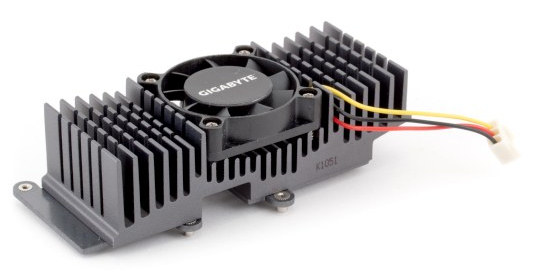As you know, Mini-ITX motherboards are niche solutions required mostly when space is limited. Their second and third most important aspects are power efficiency and noise level. For your money you can have all three, but Mini-ITX boards usually don't come cheap. On the other hand, they are already equipped with processors, and manufacturers often throw in proprietary bonuses and extra features to sweeten the deal. So, with GA-E350N-USB3, Gigabyte decided to stand out by offering quality power circuitry and a set of proprietary features normally supported by high-end full-size boards.
Design
At first glance most Mini-ITX motherboards look alike, featuring only one expansion slot. In case of AMD E-350 solutions, it's usually a PCI-Express x16 2.0 one working as x4.
Technically, even a dual-slot graphics card will fit, provided that the enclosure is big enough. But in reality even an entry-level video card will just add to power consumption while providing a minor performance boost in games. You see, AMD E-350 has a relatively fast graphics core but its processor part is just not powerful enough for handling atypical tasks. And gaming is atypical all right for a nettop, netbook or some such lightweight rig.
Moving on. USB 3.0 somewhat makes up for the lack of eSATA, although Gigabyte could have provided that too. All the more so because it wouldn't have required an additional controller. All three video interfaces is, in turn, very useful, you won't have to use adapters. By the way, GA-E350N-USB3 allows you to use two monitors at the same time, but you won't be able to use four if you install a discrete graphics card. Only outputs handled by one graphics core, be it discrete or built-in, can be used at the same time.
The cooling system is quiet enough, noise not exceeding 32 dBA (open enclosure, half a meter away) even under maximum load. When you build the machine and close the enclosure, overall noise of your rig will most likely depend on the noise produced by fans in the PSU (and other enclosure fans, if any).
The CPU VRM has 3 phases, with 2 Low RDS(on) MOSFETs per phase and ferrite chokes. There are 5 x 820 µF and 4 x 100 µF capacitors, all solid. The copper power and ground layers are double-thick. Processors with the TDP of up to 140W are supported. In other words, GA-E350N-USB3 meets Gigabyte's own Ultra Durable requirements.
The motherboard also features the second BIOS chip (and supports Dual BIOS). This helps if the primary BIOS chip fails during a firmware upgrade or something like that.
The package is typical: two SATA cables with L-shaped latches, a set of BIOS upgrade, monitoring and power-saving utilities, and Norton Internet Security.
Features
Gigabyte GA-E350N-USB3 is based on the AMD E-350 processor and the AMD M1 Hudson Southbridge. It supports up to 8GB of DDR3-800/1066/1333 memory and has 4 internal SATA 6Gbps ports. The additional controllers are listed below.
- Integrated audio based on the Realtek ALC892 codec, supporting Dolby Home Theater. There's an optical S/PDIF Out on the back panel.
- Gigabit Ethernet based on Realtek 8111E (PCIe x1).
- USB 3.0 based on Renesas D720200 (PCIe x1), supporting two USB 3.0 ports.
- System monitoring based on ITE IT8720F. BIOS has no fan control options, but, as stated above, the cooler is quiet enough even at its maximum 4300 rpm.
We tested the integrated audio solution in the 16-bit/44kHz mode using RightMark Audio Analyzer 6.2.3 and an ASUS Xonar DX sound card.
| Frequency response (40Hz to 15kHz), dB |
+0.04, -0.06 |
Excellent |
| Noise level, dB(A) |
-58.1 |
Bad |
| Dynamic range, dB(A) |
58.0 |
Bad |
| THD, % |
0.113 |
Average |
| THD + noise, dB(A) |
-52.1 |
Bad |
| IMD + noise, % |
0.374 |
Average |
| Channel crosstalk, dB |
-54.1 |
Bad |
| IMD at 10 kHz, % |
0.341 |
Average |
Overall grade: average. Well, this leaves a twofold impression. On the one hand, the test results are quite low. On the other, there were no audible artefacts. Given the results, there should've been noise in pauses between playback at the least.
The only peculiarity is that the analog output volume is too high compared to other boards. If you have passive low-impedance headphones, you'll have to lower it in the volume mixer.
Subjectively, the sound quality is acceptable for movies and pop songs. If you're into classical music where wide dynamic range is important, you will need better audio equipment (which you probably already have) connected via a digital interface.
Write a comment below. No registration needed!




